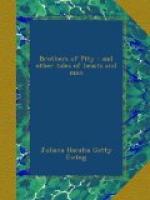“The moral of the tale, my dear children,” I was wont to say, “is, that our respected ancestor’s head saved his heels, which is never the case with giddy-pated creatures like the hare.”
“Perhaps it was a very young hare,” said Mrs. Hedgehog, who is amiable, and does not like to blame any one if it can be avoided.
“I don’t think it can have been a very young hare,” said I, “or the hedgehog would have eaten him instead of outwitting him. As it was, he placed himself and Mrs. Hedgehog at opposite ends of the course. The hare started on one side of the hedge and the hedgehog on the other. Away went the hare like the wind, but Mr. Hedgehog took three steps and went back to his place. When the hare reached his end of the hedge, Mrs. Hedgehog, from the other side, called out, ‘I’m here already.’ Her voice and her coat were very like her husband’s, and the hare was not observant enough to remark a slight difference of size and colour. The moral of which is, my dear children, that one must use his eyes as well as his legs in this world. The hare tried several runs, but there was always a hedgehog at the goal when he got there. So he gave in at last, and our ancestors walked comfortably home, taking the louis d’or and the bottle of brandy with them.”
“What is a louis d’or?” cried three of my children; and “What is brandy?” asked the other four.
“I smell valerian,” said I; on which they poked out their seven noses, and I ran at them with my spines, for a father who is not an Encyclopaedia on all fours must adopt some method of checking the inquisitiveness of the young.
When grown-up people desire information or take an interest in their neighbours, this, of course, is another matter. Mrs. Hedgehog and I had never seen tinkers, and we resolved to take an early opportunity some evening of sending the seven urchins down to the burdock plantations to pick snails, whilst we paid a cautious visit to the tinker camp.
But mothers are sad fidgets, and anxious as Mrs. Hedgehog was to gratify her curiosity, she kept putting off our expedition till the children’s spines should be harder; so I made one or two careful ones by myself, and told her all the news on my return.
CHAPTER III.
“The animal Man,” so I have heard my uncle, who was a learned hedgehog, say,—“the animal man is a diurnal animal; he comes out and feeds in the daytime.” But a second cousin, who had travelled as far as Covent Garden, and who lived for many years in a London kitchen, told me that he thought my uncle was wrong, and that man comes out and feeds at night. He said he knew of at least one house in which the crickets and black-beetles never got a quiet kitchen to themselves till it was nearly morning.
But I think my uncle was right about men in the country. I am sure the tinker and his family slept at night. He and his wife were out a great deal during the day. They went away from the wood and left the children with an old woman, who was the tinker’s mother. At one time they were away for several days, and about my usual time for going out the children were asleep, and the old woman used to sit over the camp fire with her head on her hands.




